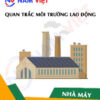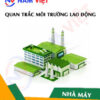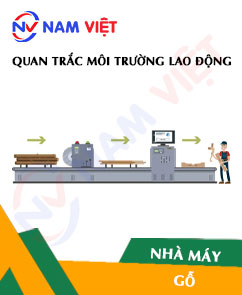Occupational environment monitoring at the alcohol factory
99,000 ₫
Note: The above price is calculated for one sample, the price may vary depending on the area of the environment that needs monitoring and the movement of the market. For more accurate price support, please refer to the quotation table or contact directly with our consulting staff.
Environmental monitoring of a alcohol factory is a session of collecting, analyzing, and evaluating factors in the workplace that may harm workers health.
Table of Contents
Toggle1. Overview of the Alcohol Factory
a. What is an Alcohol Factory?
An alcohol factory is a specialized production facility used to produce and process alcohol from ingredients such as grapes, barley, young rice, sugarcane, or other types of fruit. These factories typically apply appropriate processing methods and technology to produce alcohol with high quality and purity.
The production process in an alcohol factory includes multiple stages, from fermenting ingredients into alcohol, distilling to produce liquor, to aging and processing to create different types of alcohol with distinct flavors and aromas.
Alcohol factories usually use equipment and machinery such as fermentation systems, distillation machines, aging tanks, filtration systems, storage tanks, and bottling systems to carry out the production process efficiently and reliably.

b. Production stages in the alcohol factory
The production process in an alcohol factory can be divided into the following main stages:
- Harvesting and preparing raw materials: This stage involves harvesting and preparing the necessary ingredients for alcohol production. For wine, the main ingredient is grapes. Other ingredients such as barley, young rice, sugarcane, or fruit are used for other types of alcohol.
- Fermentation: Ingredients are fermented to convert them into alcohol. This process usually involves the action of yeast (such as wine yeast) or natural yeast (from the environment or previous batches), producing a mixture containing alcohol and other components.
- Distillation: The alcohol-containing mixture from fermentation is distilled to separate alcohol from other substances. This process is typically done by heating the mixture and using a distillation system to collect alcohol and separate residues.
- Aging: After distillation, alcohol is aged to mature and develop its flavor. Aging can last from several months to several years, depending on the type of alcohol and production style.
- Processing and refinement: After aging, alcohol may be processed and refined to achieve the desired flavor, color, and alcohol content. This includes filtration, blending, seasoning, re-distillation (if necessary), and other adjustments to reach the desired quality.
- Bottling and packaging: Alcohol is bottled and packaged in bottles, jars, boxes, or containers. Proper bottling and packaging ensure preservation and correct presentation before the product reaches the market.

c. Machinery used in the alcohol factory
Alcohol factories use various machinery to carry out production stages. Some commonly used machines include:
- Grape crusher: Used to crush grapes and separate skins to extract juice for fermentation.
- Press or juice extractor: Used to extract juice from fruits or other ingredients such as grapes, apples, pears, oranges, pineapples, etc.
- Fermentation tanks: Used to ferment ingredients like grapes or other raw materials into an alcohol-containing mixture.
- Aging tanks: Used to age alcohol after distillation, allowing it to mature and develop flavor.
- Distillation machines: Used to distill the alcohol-containing mixture to separate alcohol from other substances.
- Mixing tanks: Used to blend different components to achieve the desired flavor, color, and alcohol content.
- Filtration machines: Used to filter alcohol and remove impurities, producing clear and clean alcohol.
- Bottling and packaging machines: Used for bottling alcohol and packaging the final product, including capping machines, labeling machines, boxing, and other packaging equipment.

d. Occupational diseases in alcohol factory workers
Workers in alcohol factories may be at risk of some occupational diseases related to production and handling of alcohol. Common occupational diseases include:
- Respiratory diseases: Exposure to chemicals during production may irritate or damage the respiratory system, causing rhinitis, pharyngitis, bronchitis, and other respiratory issues.
- Skin diseases: Contact with chemicals may cause skin irritation, dermatitis, eczema, discharge, or red and itchy spots on the skin.
- Digestive diseases: Long-term exposure to chemicals in alcohol may affect the digestive system, causing stomach, intestinal, or liver problems.
- Nervous system disorders: Exposure to alcohol and other compounds may cause neurological issues such as tremors, insomnia, arrhythmia, and other nerve-related problems.
- Occupational accidents: Risks include collisions, cuts, burns from machinery, bottles, or chemical handling.
Preventive measures include implementing occupational safety protocols, using personal protective equipment, proper chemical handling guidance, and strict safety management in the alcohol factory.

e. Popular types of alcohol on the market
Popular types of alcohol include:
- Wine: Includes red, white, and rosé wine. Made from grapes, with flavor and aroma varying depending on grape type and distillation process.
- Spirits: Includes whisky, rum, vodka, brandy, and other spirits, distilled from ingredients such as barley, sugarcane, grapes, apples, pears, and more.
- Celebration alcohol: Includes champagne and other sparkling wines. High-pressure bottles create fizz and are used for special occasions.
- Fruit alcohol: Includes apple, grape, plum, raspberry, and other fruit alcohols, made from fresh or fermented fruit for natural flavor and aroma.
- Honey alcohol: Distilled from honey, with a distinctive aroma, consumed directly or as cocktail ingredients.
- Sake: Traditional Japanese alcohol made from rice and yeast, with a smooth and mild flavor, typically consumed warm or cold.
2. Overview of Occupational Environment Monitoring Services
a. What is occupational environment monitoring at an alcohol factory?
Occupational environment monitoring at an alcohol factory is the activity of collecting, evaluating, and analyzing measurement indicators of workplace environmental factors. The goal is to implement timely measures to minimize environmental impacts on workers’ health and prevent occupational diseases. Occupational environment monitoring is mandatory for alcohol factories.
This monitoring plays a critical role in protecting and enhancing workers’ health, as the workforce is the primary resource generating profits. Workers regularly exposed to hazards beyond permissible limits may suffer health effects and occupational diseases.
REGISTER FOR OCCUPATIONAL ENVIRONMENT MONITORING SERVICE
b. Nam Viet’s occupational environment monitoring program
Nam Viet’s program is developed by monitoring engineers in occupational safety and environmental protection. Its goal is to ensure workers’ health and safety through modern measurement methods, monitoring air, water, microclimate, physical, and dust factors in the workplace. This program is crucial for a safe working environment and worker health protection.
It also plays a key role in researching and developing solutions to improve workplace quality. With dedicated and professional monitoring experts, Nam Viet’s proprietary program is a breakthrough in labor safety and environmental management in Vietnam.

c. Standardization in occupational environment measurement procedures
Standardization in Nam Viet’s measurement procedures ensures accuracy and reliability. The program applies recognized standards and procedures from the Ho Chi Minh City Department of Health. This guarantees reliable data for workplace evaluation and informed decisions to protect workers’ health.
Standardized procedures are conducted by highly skilled monitoring experts, providing managers and specialists with trustworthy results for accurate, valuable decisions in worker health protection and environmental management.
By applying standardized procedures, Nam Viet demonstrates its commitment to a safe working environment and worker health protection while contributing to improved labor safety and environmental management in Vietnam.
d. Reporting alcohol factory monitoring results
Monitoring results are prepared according to Form 04, Appendix III, issued with Decree 44/2016/ND-CP in two copies: one sent to the factory that signed the monitoring contract and one kept by the monitoring organization.
Records of monitoring results are retained indefinitely as required by law.

e. Frequency of occupational environment monitoring by law
According to clause 2 of Article 18 of the Law on Occupational Safety and Hygiene 84/2015/QH13, employers must organize occupational environment monitoring to evaluate harmful factors at least once a year.
f. Deadline for submitting monitoring reports by law
Reports must be submitted before December 31 each year. Production enterprises are required to submit their monitoring results to the Department of Health where the business is headquartered and where workers are employed.
When there are changes in technology, production processes, or facility upgrades that may introduce new hazards, production enterprises must update occupational hygiene records related to harmful factors and perform the necessary environment monitoring.
g. Penalties for violations of occupational environment monitoring regulations
According to Article 27 of Decree 12/2022/ND-CP dated January 17, 2022, on administrative penalties in labor, social insurance, and Vietnamese workers working abroad under contract:
- Clause 2: Fines of 2,000,000 – 5,000,000 VND for employers who fail to publicly disclose monitoring results and hazard assessments to workers immediately after completion.
- Clause 3: Fines of 20,000,000 – 40,000,000 VND for employers who fail to conduct occupational environment monitoring as required by law.
- Clause 4: Fines of 40,000,000 – 60,000,000 VND for employers who collude with monitoring organizations to falsify results but not to the extent of criminal liability.
3. Harmful environmental factors for workers in alcohol manufacturing factories
In alcohol manufacturing factories, several environmental factors can harm workers. Some of these factors include:
- Alcohol vapors: The alcohol production process involves distillation and evaporation. Exposure to alcohol vapors can be addictive and affect workers’ health if excessive. It may cause respiratory, neurological, and liver issues.
- Chemicals: Alcohol production may involve chemicals such as cleaning agents, disinfectants, and preservatives. Long-term exposure to these chemicals can irritate the skin, eyes, and respiratory system, and may impact health if not used properly.
- Odors and emissions: The production process can produce characteristic odors and emissions. Some aromatic substances and organic compounds may cause irritation and affect the respiratory system, causing discomfort for workers if not controlled.
- Noise: Alcohol manufacturing may generate noise from machinery and equipment. High and continuous noise can cause stress, sleep disturbances, and negatively affect workers’ physical and mental health.
- Working conditions: Alcohol factories often have specific working conditions such as high temperature, humidity, and exposure to liquids. Poor environmental conditions can cause stress, fatigue, and affect overall worker health.
REGISTER FOR OCCUPATIONAL ENVIRONMENT MONITORING SERVICE
4. Measures to improve the working environment in alcohol manufacturing factories
To improve the working environment in alcohol manufacturing factories and protect workers’ health, the following measures can be implemented:
- Ensure ventilation and exhaust fans: Provide effective ventilation and exhaust systems to remove smoke, alcohol vapors, and other harmful substances from the air. This helps reduce worker exposure to hazards and improves indoor air quality.
- Use personal protective equipment: Ensure workers are fully equipped with PPE such as gas masks, gloves, safety goggles, chemical-resistant clothing, and safety shoes to prevent direct contact with hazardous substances.
- Training and education: Provide occupational safety and health training to workers. Ensure they understand potential risks and know how to properly use protective equipment, handle harmful substances, and prevent occupational diseases.
- Waste management: Ensure proper handling of waste generated from alcohol production, complying with environmental standards. Alcohol must also be safely stored and managed to prevent fire hazards.
- Equipment inspection and maintenance: Conduct regular checks and maintenance of machinery and equipment to ensure safe and efficient operation. This reduces the risk of accidents and protects workers’ health.
- Enhance personal hygiene: Encourage workers to follow personal hygiene regulations, including frequent handwashing, proper use of hygiene products, and avoiding contact with food or beverages during work.
- Periodic health checks: Conduct regular health screenings for workers to detect potential work-related health issues early and implement preventive or corrective measures as needed.
- Fire and explosion risk management: Apply fire and explosion safety measures, including controlling electrical sources, using explosion-proof equipment, and following safety regulations when handling flammable substances.
- Regularly conduct occupational environment monitoring in factories, collecting and analyzing harmful factors to adjust and reduce hazards and prevent occupational diseases for workers.
5. Benefits of periodic monitoring in alcohol manufacturing factories
An Toan Nam Viet provides enterprises with excellent benefits when using occupational environment monitoring services in accordance with Decree 44/2016/NĐ – CP on managing and controlling harmful factors in the working environment affecting employees.
- Enterprises can proactively control harmful factors in workshops or factories.
- Receive recommendations on measures to reduce harmful factors and improve workplace quality.
- Indirectly protect human resources, the key factor in enterprise development.
- Reduce the impact of occupational diseases on health, thereby minimizing future medical costs.
- Improved worker health enhances product quality and ensures stable production output.
- Ensure compliance with labor safety laws and avoid legal risks.
- Enhance credibility and professionalism in all aspects, elevating the enterprise’s brand.
Nam Viet’s environmental monitoring service is a solution to reduce occupational disease risks, contributing to a healthy and high-quality working environment.

6. National occupational environment monitoring center
Nam Viet Occupational Environment Monitoring Center is a professional unit specializing in monitoring and measuring occupational environment quality across all provinces in Vietnam. With an experienced team of monitoring specialists, the center uses modern measurement equipment, ensuring accuracy and reliability.
In addition to monitoring services, the center assists clients in planning, managing, and tracking occupational environment issues. With the motto “customers are central,” the center prioritizes customer satisfaction, meets all client needs, and is committed to providing the best solutions for enterprises.
REGISTER FOR OCCUPATIONAL ENVIRONMENT MONITORING SERVICE
With investments in technology, equipment, and human resources, Nam Viet’s monitoring center has become one of the most reputable units in occupational environment monitoring in Ho Chi Minh City, with the following goals:
- We always value our brand reputation and the quality of our services.
- We provide clients with the best and most suitable solutions possible.
- Along with a team of experienced Masters and Engineers, we aim to protect the environment and benefit enterprises.
- Working with Nam Viet Monitoring Team, companies will receive professional service from experts and enjoy the best cost advantages.
The occupational environment monitoring process at Nam Viet includes the following basic steps:
- Before monitoring, our company ensures all machinery and equipment are calibrated and adjusted according to legal regulations.
- Strictly follow the occupational environment monitoring procedures as committed to the Department of Health.
- Accurately report monitoring results to employers.
- If monitoring results indicate unsafe conditions for workers, Nam Viet will support remedial measures, and the workplace shall implement:
- Implement measures to improve working conditions to minimize harmful impacts and prevent occupational diseases.
- Organize health checks to detect occupational and work-related illnesses early for workers in unsafe environments.
- Provide allowances in kind for workers according to labor law regulations.

7. Occupational environment monitoring service quotation
To help enterprises perform occupational environment monitoring professionally and effectively, Nam Viet provides customers with a detailed quotation for occupational environment monitoring services with quality and reasonable cost.
- Our quotation provides detailed pricing information for the monitoring services we offer, including costs related to transportation, measurement, analysis, and reporting. Customers can fully rely on the accuracy and reliability of the monitoring reports we provide.
- We are committed to offering the most competitive and reasonable prices on the market and are ready to provide prompt and professional consultation for any questions regarding monitoring services.
- With Nam Viet’s monitoring quotation, customers can easily select service packages that suit their needs. We are committed to delivering the highest satisfaction with professional service quality.
No comments yet












Review Occupational environment monitoring at the alcohol factory
There are no reviews yet.